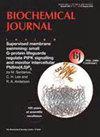膜破坏减弱前列腺素受体的激动剂效力。
IF 4.3
3区 生物学
Q2 BIOCHEMISTRY & MOLECULAR BIOLOGY
引用次数: 0
摘要
G蛋白偶联受体(gpcr)是关键的信号转导器,大约三分之一的fda批准药物的靶标。许多结构和药理学研究依赖于破坏的膜条件,例如人工系统中纯化的受体或使用膜片段进行放射性配体结合试验,尽管尚未系统地研究膜完整性是否影响GPCR功能。为了解决这个问题,我们开发了Förster共振能量转移(FRET)为基础的GPCR构象传感器,以直接测量受体激活在完整和破坏膜。我们的研究结果表明,虽然一些gpcr不受影响,但前列腺素受体构象传感器表现出对膜完整性的强烈依赖:它们的激动剂和拮抗剂的效力在膜破坏后降低了30倍,揭示了膜完整性在配体受体亲和力中的关键作用。野生型受体在功能信号分析中的验证证实,这些效应反映了真正的受体特征,而不是来自传感器设计的非特异性信号。我们排除了几个可以解释亲和力丧失的因素,但无法完全阐明这一现象背后的机制。然而,这种效应可能会在结构和药理学研究中引入偏见。因此,必须考虑膜的完整性,并采用优化的实验策略,以确保稳健和可靠的数据解释。本文章由计算机程序翻译,如有差异,请以英文原文为准。
Membrane disruption attenuates agonist potency in prostanoid receptors.
G protein-coupled receptors (GPCRs) are key signal transducers and the target of about one-third of all FDA-approved drugs. Many structural and pharmacological studies rely on disrupted membrane conditions, such as purified receptors in artificial systems or radioligand binding assays using membrane fragments, even though it had not been systematically studied whether membrane integrity affects GPCR function. To address this, we developed Förster resonance energy transfer (FRET)-based GPCR conformation sensors to directly measure receptor activation in both intact and disrupted membranes. Our results show that while some GPCRs remain unaffected, prostanoid receptor conformation sensors exhibit a strong dependence on membrane integrity: their agonist and antagonist potencies decrease up to 30-fold upon membrane disruption, revealing a crucial role of the membrane integrity in ligand-receptor affinity. Validation with wild-type receptors in functional signaling assays confirmed that these effects reflect genuine receptor characteristics rather than unspecific signals from the sensor design. We ruled out several factors that could explain the loss of affinity, but were unable to fully elucidate the mechanism behind this phenomenon. Nevertheless, this effect may introduce bias into structural and pharmacological studies. It is therefore essential to account for membrane integrity and to employ optimized experimental strategies to ensure robust and reliable data interpretation.
求助全文
通过发布文献求助,成功后即可免费获取论文全文。
去求助
来源期刊

Biochemical Journal
生物-生化与分子生物学
CiteScore
8.00
自引率
0.00%
发文量
255
审稿时长
1 months
期刊介绍:
Exploring the molecular mechanisms that underpin key biological processes, the Biochemical Journal is a leading bioscience journal publishing high-impact scientific research papers and reviews on the latest advances and new mechanistic concepts in the fields of biochemistry, cellular biosciences and molecular biology.
The Journal and its Editorial Board are committed to publishing work that provides a significant advance to current understanding or mechanistic insights; studies that go beyond observational work using in vitro and/or in vivo approaches are welcomed.
Painless publishing:
All papers undergo a rigorous peer review process; however, the Editorial Board is committed to ensuring that, if revisions are recommended, extra experiments not necessary to the paper will not be asked for.
Areas covered in the journal include:
Cell biology
Chemical biology
Energy processes
Gene expression and regulation
Mechanisms of disease
Metabolism
Molecular structure and function
Plant biology
Signalling
 求助内容:
求助内容: 应助结果提醒方式:
应助结果提醒方式:


